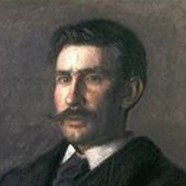 Name of interviewee: Edward W. Redfield
Name of interviewee: Edward W. Redfield
Date of birth/age at interview: 1869/93
Interviewers: Charles Hargens, Jr., Harry Leith-Ross, John Richardson
Interview date: February 20, 1963
Interview location: Redfield home, Centre Bridge
Interview length: 1 hour
Time span discussed: 1869 to 1963
Summary: This appears to be an original tape for what was eventually an edited version. Clearly much of it is reproduced in the final (Redfield recording 2), but some of the stories here are not edited for length and give interesting comments. In particular we see a more critical side of Edward Redfield, who acknowledged he did not shy away from telling it as he saw it. (The listener who has heard some of these stories can shorten listening time by looking at the time markers as they go and skipping repeated stories.)
Time markers:
00:08 – his entry in competition for artists under 36 years of age; spoke his mind about injustices
03:28 – stories about Kenyon Cox
04:57 – Panama-Pacific International Exhibition, Joseph Pennell, Cecilia Beaux, John Singer Sargent; story about jury work (also in Redfield recording 2)
13:01 – story of fake Redfield paintings
17:40 – Redfield’s opinion of signs in New Hope
18:14 – continued story of fake Redfield paintings
19:33 – mention of Carl Weber (also in Redfield recording 2)
21:31 – who first on local art scene, Lathrop or Redfield (also in Redfield recording 2)
22: 17 – Dr. George Marshall; first purchase of Centre Bridge property
23:28 – moved to area in 1898, then year in France; was poor (also in Redfield recording 2, expanded here)
24:57 – Alexander Harrison, teacher of Tony Leith-Ross
25:37 – never went hungry: fished, hunted, trapped, gardened, raised chickens and a cow
26:39 – artists in area before he arrived: Carl Weber in Point Pleasant, Martin Heade in Lumberville, George Inness (also in Redfield recordings 1 and 2)
28:00 – second home in Booth Bay, ME; Winslow Homer in Maine; Alexander Bower
28:45 – John Trask, Philadelphia Sesquicentennial art director, Bower assistant director, director when Trask died
32:50 – story of placing all the pictures for exhibition
36:18 – stories about crooked dealings in art world
39:30 – Richardson reads his short biography of Redfield looking for agreement on facts (and the praise Richardson lays on) (also in Redfield recording 2)
40:38 – sold paintings from room in New York; Mrs. Harriman bought a Redfield painting and gave it to the Metropolitan
42:50 – story about unsuccessfully trying to trade that picture for a different one for the Metropolitan
44:03 – Williamson at the Corcoran gallery, judgment on modern art (also in Redfield recording 2, expanded here)
45:33 – story about Philadelphia Record and reproductions of art, caricatures of modern art (few sentences repeated within)
48:07 – comments of painters like Vermeer; some art he does not like; discusses various artists, juries, shows; views on some artists he knew
56:34 – story about painting by artist friend, he purchased and resold
